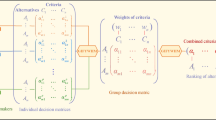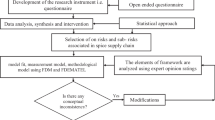Abstract
Uncertainty and risk are inevitable issues in decision making in supply chain systems. In knowledge-based communities, uncertain conditions are recognized, analyzed and eliminated using wide range of concepts and approaches. One intelligent tool to aid in decreasing impreciseness and in delivering an acceptable level of accuracy is fuzzy logic. This study reports a new version of the fuzzy multiple criteria decision-making family. The decision-making trial and evaluation laboratory (DEMATEL) is extended for the first time with interval fuzzy values and then integrated as an input for the quality function deployment (QFD) mechanism. Although the application of decision-making tools in the supply chain and its sustainable development is undeniable, the implementation of fuzzy decision support systems in sustainable supply chains still demands more research work. This study develops an IT2F DEMATEL-QFD model to evaluate and rank sustainable supply chain drivers in a group decision-making environment. The proposed fuzzy decision model is connected to a real research project for eliminating risks in the supply chain related to agricultural production systems. Sensitivity analysis confirms the stability of the model. It is concluded that the outcomes and advantages of the newly developed model will profit academic and non-academic partners.





Similar content being viewed by others
References
Abdullah L, Najib L (2014) A new type-2 fuzzy set of linguistic variables for the fuzzy analytic hierarchy process. Expert Syst Appl 41(7):3297–3305
Abdullah L, Zulkifli N (2015) Integration of fuzzy AHP and interval type-2 fuzzy DEMATEL: an application to human resource management. Expert Syst Appl 42(9):4397–4409
Ahi P, Searcy C (2013) A comparative literature analysis of definitions for green and sustainable supply chain management. J Clean Prod 52:329–341
Azadi M, Jafarian M, Saen RF, Mirhedayatian SM (2015) A new fuzzy DEA model for evaluation of efficiency and effectiveness of suppliers in sustainable supply chain management context. Comput Oper Res 54:274–285
Azevedo SG, Carvalho H, Ferreira LM, Matias JC (2017) A proposed framework to assess upstream supply chain sustainability. Environ Dev Sustain 19(6):2253–2273
Baykasoğlu A, Gölcük İ (2017) Development of an interval type-2 fuzzy sets based hierarchical MADM model by combining DEMATEL and TOPSIS. Expert Syst Appl 70:37–51
Beske P, Land A, Seuring S (2014) Sustainable supply chain management practices and dynamic capabilities in the food industry: a critical analysis of the literature. Int J Prod Econ 152:131–143
Bevilacqua M, Ciarapica FE, Giacchetta G (2006) A fuzzy-QFD approach to supplier selection. J Purch Supply Manage 12(1):14–27
Bhattacharya A, Mohapatra P, Kumar V, Dey PK, Brady M, Tiwari MK, Nudurupati SS (2014) Green supply chain performance measurement using fuzzy ANP-based balanced scorecard: a collaborative decision-making approach. Prod Plan Control 25(8):698–714
Boukherroub T, Ruiz A, Guinet A, Fondrevelle J (2015) An integrated approach for sustainable supply chain planning. Comput Oper Res 54:180–194
Büyüközkan G, Berkol Ç (2011) Designing a sustainable supply chain using an integrated analytic network process and goal programming approach in quality function deployment. Expert Syst Appl 38(11):13731–13748
Büyüközkan G, Cifci G (2013) An integrated QFD framework with multiple formatted and incomplete preferences: a sustainable supply chain application. Appl Soft Comput 13(9):3931–3941
Büyüközkan G, Çifçi G (2012) A novel hybrid MCDM approach based on fuzzy DEMATEL, fuzzy ANP and fuzzy TOPSIS to evaluate green suppliers. Expert Syst Appl 39(3):3000–3011
Büyüközkan G, Göçer F, Feyzioğlu O (2018) Cloud computing technology selection based on interval-valued intuitionistic fuzzy MCDM methods. Soft Comput 22(15):5091–5114
Can GF, Delice EK (2018) A task-based fuzzy integrated MCDM approach for shopping mall selection considering universal design criteria. Soft Comput 22(22):7377–7397
Cebi S, Ozkok M, Demirci E (2014) Evaluation of design parameters for vessel engine room by using a modified QFD technique. J Mult Value Log Soft Comput 23(5):559–587
Celik E, Akyuz E (2018) An interval type-2 fuzzy AHP and TOPSIS methods for decision-making problems in maritime transportation engineering: the case of ship loader. Ocean Eng 155:371–381
Celik M, Cebi S, Kahraman C, Er ID (2009) An integrated fuzzy QFD model proposal on routing of shipping investment decisions in crude oil tanker market. Expert Syst Appl 36(3):6227–6235
Celik E, Bilisik ON, Erdogan M, Gumus AT, Baracli H (2013) An integrated novel interval type-2 fuzzy MCDM method to improve customer satisfaction in public transportation for Istanbul. Trans Res E Log Trans Rev 58:28–51
Celik E, Aydin N, Gumus AT (2014) A multiattribute customer satisfaction evaluation approach for rail transit network: a real case study for Istanbul, Turkey. Transp Policy 36:283–293
Cevik Onar S, Oztaysi B, Kahraman C (2014) Strategic decision selection using hesitant fuzzy TOPSIS and interval type-2 fuzzy AHP: a case study. Int J Comput intell Syst 7(5):1002–1021
Chahal H, Sharma RD (2006) Implications of corporate social responsibility on marketing performance: a conceptual framework. J Serv Res 6(1):205
Chen TY (2014a) A PROMETHEE-based outranking method for multiple criteria decision analysis with interval type-2 fuzzy sets. Soft Comput 18(5):923–940
Chen TY (2014b) An ELECTRE-based outranking method for multiple criteria group decision making using interval type-2 fuzzy sets. Inf Sci 263:1–21
Chen SM, Lee LW (2010a) Fuzzy multiple attributes group decision-making based on the ranking values and the arithmetic operations of interval type-2 fuzzy sets. Expert Syst Appl 37(1):824–833
Chen SM, Lee LW (2010b) Fuzzy multiple attributes group decision-making based on the interval type-2 TOPSIS method. Expert Syst Appl 37(4):2790–2798
Chen TY, Chang CH, Lu JFR (2013) The extended QUALIFLEX method for multiple criteria decision analysis based on interval type-2 fuzzy sets and applications to medical decision making. Eur J Oper Res 226(3):615–625
Deveci M, Demirel NÇ, Ahmetoğlu E (2017) Airline new route selection based on interval type-2 fuzzy MCDM: a case study of new route between Turkey-North American region destinations. J Air Transp Manage 59:83–99
Deveci M, Canıtez F, Gökaşar I (2018) WASPAS and TOPSIS based interval type-2 fuzzy MCDM method for a selection of a car sharing station. Sustain Cities Soc 41:777–791
Diabat A, Govindan K (2011) An analysis of the drivers affecting the implementation of green supply chain management. Resour Conserv Recycl 55(6):659–667
Dorfeshan Y, Mousavi SM (2019) A new interval type-2 fuzzy decision method with an extended relative preference relation and entropy to project critical path selection. Int J Fuzzy Syst Appl (IJFSA) 8(1):19–47
Dotoli M, Falagario M (2012) A hierarchical model for optimal supplier selection in multiple sourcing contexts. Int J Prod Res 50(11):2953–2967
Dymova L, Sevastjanov P, Tikhonenko A (2015) An interval type-2 fuzzy extension of the TOPSIS method using alpha cuts. Knowl-Based Syst 83:116–127
Erol I, Sencer S, Sari R (2011) A new fuzzy multi-criteria framework for measuring sustainability performance of a supply chain. Ecol Econ 70(6):1088–1100
Gao QS, Lu L (2013) The factors analysis of agricultural products quality safety- Based on DEMATEL and QFD method. Complex Syst Complex Sci 10(1):89–94
Ghorabaee MK (2016) Developing an MCDM method for robot selection with interval type-2 fuzzy sets. Robot Comput Integr Manufact 37:221–232
Ghorabaee MK, Amiri M, Sadaghiani JS, Goodarzi GH (2014) Multiple criteria group decision-making for supplier selection based on COPRAS method with interval type-2 fuzzy sets. Int J Adv Manuf Technol 75(5–8):1115–1130
Ghorabaee MK, Zavadskas EK, Amiri M, Esmaeili A (2016) Multi-criteria evaluation of green suppliers using an extended WASPAS method with interval type-2 fuzzy sets. J Clean Prod 137:213–229
Gitinavard H, Mousavi SM, Vahdani B (2017) Soft computing-based new interval-valued hesitant fuzzy multi-criteria group assessment method with last aggregation to industrial decision problems. Soft Comput 21(12):3247–3265
Govindan K, Khodaverdi R, Vafadarnikjoo A (2015) Intuitionistic fuzzy based DEMATEL method for developing green practices and performances in a green supply chain. Expert Syst Appl 42(20):7207–7220
Gul M, Celik E, Gumus AT, Guneri AF (2016) Emergency department performance evaluation by an integrated simulation and interval type-2 fuzzy MCDM-based scenario analysis. Eur J Ind Eng 10(2):196–223
Hart SL, Milstein MB (2003) Creating sustainable value. Acad Manage Exec 17(2):56–67
Houda M, Said T (2011) Sustainability metrics for a supply chain: the case of small and medium enterprises, Logistics (LOGISTIQUA). In: 2011 4th international conference on res. unit in logistics, ind. manage. & quality (LOGIQ), ISGI-Sfax, Sfax, Tunisia, pp 109e114. http://dx.doi.org/10.1109/ LOGISTIQUA.2011.5939411
Hussain, M. (2011). Modelling the enablers and alternatives for sustainable supply chain management (Doctoral dissertation, Concordia University)
Ignatius J, Rahman A, Yazdani M, Šaparauskas J, Haron SH (2016) An Integrated fuzzy ANP–QFD approach for green building assessment. J Civ Eng Manage 22(4):551–563
Jato-Espino D, Rodriguez-Hernandez J, Andrés-Valeri VC, Ballester-Muñoz F (2014) A fuzzy stochastic multi-criteria model for the selection of urban pervious pavements. Expert Syst Appl 41(15):6807–6817
Juan YK, Perng YH, Castro-Lacouture D, Lu KS (2009) Housing refurbishment contractors selection based on a hybrid fuzzy-QFD approach. Autom Constru 18(2):139–144
Kahraman C, Öztayşi B, Sarı İU, Turanoğlu E (2014) Fuzzy analytic hierarchy process with interval type-2 fuzzy sets. Knowl-Based Syst 59:48–57
Kannan D, Khodaverdi R, Olfat L, Jafarian A, Diabat A (2013) Integrated fuzzy multi criteria decision making method and multi-objective programming approach for supplier selection and order allocation in a green supply chain. J Clean Prod 47:355–367
Karsak EE, Dursun M (2015) An integrated fuzzy MCDM approach for supplier evaluation and selection. Comput Ind Eng 82:82–93
Erdoğan M, Kaya I (2016) A combined fuzzy approach to determine the best region for a nuclear power plant in Turkey. Appl Soft Comput 39:84–93
Keshavarz Ghorabaee M, Amiri M, Kazimieras Zavadskas E, Antuchevičienė J (2017) Assessment of third-party logistics providers using a CRITIC–WASPAS approach with interval type-2 fuzzy sets. Transport 32(1):66–78
Kiliç M, Kaya İ (2015) Investment project evaluation by a decision making methodology based on type-2 fuzzy sets. Appl Soft Comput 27:399–410
Kundu P, Kar S, Maiti M (2017) A fuzzy multi-criteria group decision making based on ranking interval type-2 fuzzy variables and an application to transportation mode selection problem. Soft Comput 21(11):3051–3062
Lee CKM, Ru CTY, Yeung CL, Choy KL, Ip WH (2015) Analyze the healthcare service requirement using fuzzy QFD. Comput Ind 74:1–15
Li H, Pan Y, Zhou Q (2015) Filter design for interval type-2 fuzzy systems with D stability constraints under a unified frame. IEEE Trans Fuzzy Syst 23(3):719–725
Lima-Junior FR, Carpinetti LCR (2016) A multicriteria approach based on fuzzy QFD for choosing criteria for supplier selection. Comput Ind Eng 101:269–285
Lin C-L, Wu W-W (2004) A fuzzy extension of the DEMATEL method for group decision making. Eur J Oper Res 156:445–455
Marshall D, McCarthy L, Heavey C, McGrath P (2015) Environmental and social supply chain management sustainability practices: construct development and measurement. Prod Plan Control 26(8):673–690
Mendel JM, John RI, Liu F (2006) Interval type-2 fuzzy logic systems made simple. IEEE Trans Fuzzy Syst 14(6):808–821
Nishat Faisal M (2010) Sustainable supply chains: a study of interaction among the enablers. Bus Process Manage J 16(3):508–529
Onar SÇ, Büyüközkan G, Öztayşi B, Kahraman C (2016) A new hesitant fuzzy QFD approach: an application to computer workstation selection. Appl Soft Comput 46:1–16
Pitchipoo P, Venkumar P, Rajakarunakaran S (2013) Fuzzy hybrid decision model for supplier evaluation and selection. Int J Prod Res 51(13):3903–3919
Qin J, Liu X, Pedrycz W (2015) An extended VIKOR method based on prospect theory for multiple attribute decision making under interval type-2 fuzzy environment. Knowl-Based Syst 86:116–130
Qin J, Liu X, Pedrycz W (2017) An extended TODIM multi-criteria group decision making method for green supplier selection in interval type-2 fuzzy environment. Eur J Oper Res 258(2):626–638
Sang X, Liu X (2016) An interval type-2 fuzzy sets-based TODIM method and its application to green supplier selection. J Oper Res Soc 67(5):722–734
Seuring S (2013) A review of modeling approaches for sustainable supply chain management. Decis Support Syst 54(4):1513–1520
Shaw S, Grant DB, Mangan J (2010) Developing environmental supply chain performance measures. Benchmark Int J 17(3):320–339
Sohn SY, Choi IS (2001) Fuzzy QFD for supply chain management with reliability consideration. Reliab Eng Syst Safe 72(3):327–334
Soner O, Celik E, Akyuz E (2017) Application of AHP and VIKOR methods under interval type 2 fuzzy environment in maritime transportation. Ocean Eng 129:107–116
Tadić S, Zečević S, Krstić M (2014) A novel hybrid MCDM model based on fuzzy DEMATEL, fuzzy ANP and fuzzy VIKOR for city logistics concept selection. Expert Syst Appl 41(18):8112–8128
Tavana M, Yazdani M, Di Caprio D (2017) An application of an integrated ANP–QFD framework for sustainable supplier selection. Int J Log Res Appl 20(3):254–275
Topaloglu M, Yarkin F, Kaya T (2018) Solid waste collection system selection for smart cities based on a type-2 fuzzy multi-criteria decision technique. Soft Comput 22(15):4879–4890
Tsai WH, Chou WC (2009) Selecting management systems for sustainable development in SMEs: a novel hybrid model based on DEMATEL, ANP, and ZOGP. Expert Syst Appl 36(2):1444–1458
Tseng ML (2009) Application of ANP and DEMATEL to evaluate the decision-making of municipal solid waste management in Metro Manila. Environ Monit Assess 156(1–4):181–197
Tzeng GH, Chiang CH, Li CW (2007) Evaluating intertwined effects in e-learning programs: a novel hybrid MCDM model based on factor analysis and DEMATEL. Expert Syst Appl 32(4):1028–1044
Wang YL, Tzeng GH (2012) Brand marketing for creating brand value based on a MCDM model combining DEMATEL with ANP and VIKOR methods. Expert Syst Appl 39(5):5600–5615
Wang W, Liu X, Qin Y (2012) Multi-attribute group decision making models under interval type-2 fuzzy environment. Knowl-Based Syst 30:121–128
Wu WW (2008) Choosing knowledge management strategies by using a combined ANP and DEMATEL approach. Expert Syst Appl 35(3):828–835
Wu WW, Lee YT (2007) Developing global managers’ competencies using the fuzzy DEMATEL method. Expert Syst Appl 32(2):499–507
Yang JL, Tzeng GH (2011) An integrated MCDM technique combined with DEMATEL for a novel cluster-weighted with ANP method. Expert Syst Appl 38(3):1417–1424
Yang YPO, Shieh HM, Leu JD, Tzeng GH (2008) A novel hybrid MCDM model combined with DEMATEL and ANP with applications. Int J Oper Res 5(3):160–168
Yazdani M, Hashemkhani Zolfani S, Zavadskas EK (2016) New integration of MCDM methods and QFD in the selection of green suppliers. J Bus Econ Manag 17(6):1097–1113
Yazdani M, Chatterjee P, Zavadskas EK, Zolfani SH (2017a) Integrated QFD-MCDM framework for green supplier selection. J Clean Prod 142:3728–3740
Yazdani M, Zarate P, Coulibaly A, Zavadskas EK (2017b) A group decision making support system in logistics and supply chain management. Expert Syst Appl 88:376–392
Zaim S, Sevkli M, Camgöz-Akdağ H, Demirel OF, Yayla AY, Delen D (2014) Use of ANP weighted crisp and fuzzy QFD for product development. Expert Syst Appl 41(9):4464–4474
Zarghami M, Szidarovszky F, Ardakanian R (2008) A fuzzy-stochastic OWA model for robust multi-criteria decision making. Fuzzy Optim Decis Making 7(1):1–15
Zhang Z, Zhang S (2013) A novel approach to multi attribute group decision making based on trapezoidal interval type-2 fuzzy soft sets. Appl Math Model 37(7):4948–4971
Acknowledgements
The work described in this paper was supported by grants from The National Natural Science Foundation of China (Grant No. 71901052).
Author information
Authors and Affiliations
Corresponding author
Ethics declarations
Conflict of interest
All the three authors declare that they have no conflict of interest.
Ethical approval
This study does not involve any human participants or animals’ studies performed by any of the authors.
Additional information
Communicated by V. Loia.
Publisher's Note
Springer Nature remains neutral with regard to jurisdictional claims in published maps and institutional affiliations.
Rights and permissions
About this article
Cite this article
Yazdani, M., Wang, Z.X. & Chan, F.T.S. A decision support model based on the combined structure of DEMATEL, QFD and fuzzy values. Soft Comput 24, 12449–12468 (2020). https://doi.org/10.1007/s00500-020-04685-2
Published:
Issue Date:
DOI: https://doi.org/10.1007/s00500-020-04685-2




